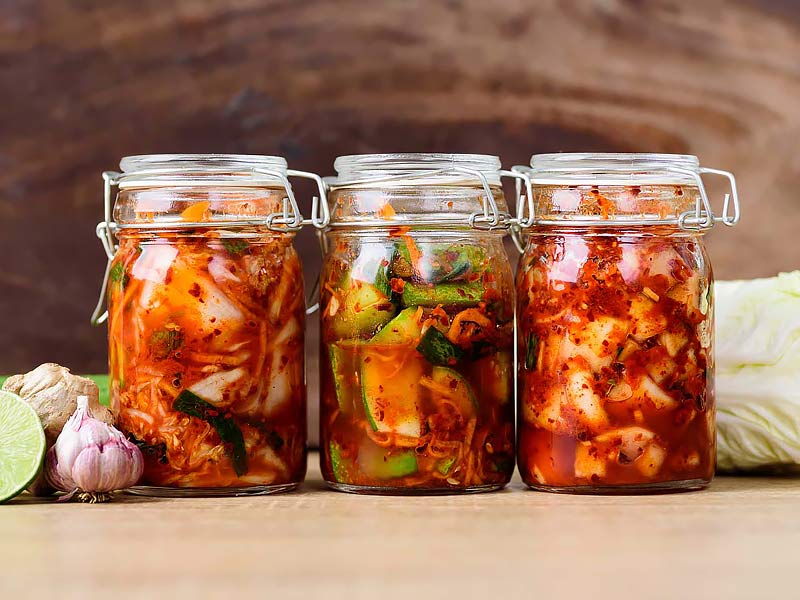“From Kimchi to Sauerkraut: 7 Fermented Foods From Around the World” delves into the flavorful and varied realm of fermented foods.

This article presents ten delectable and culturally significant fermented dishes that offer distinct flavors and numerous health benefits, ranging from Korea’s spicy kimchi to Germany’s tart sauerkraut.
Korean kimchi:
Traditionally made from fermented vegetables such as cabbage, radishes, scallions, garlic, ginger, and chilli pepper flakes, kimchi is a spicy and tangy Korean dish. It has a distinct taste that can range from mildly spicy to extremely fiery, depending on the recipe and personal preference. It also has a strong, pungent aroma. Kimchi is a common side dish in Korean cooking that is usually served with rice and other main courses. In addition, it can be a component of many different recipes, such as burgers, fried rice, stews, and pancakes.
German sauerkraut:
Beyond its connection to Germany, the sour and fermented cabbage dish known as sauerkraut boasts an intriguing past. Despite its widespread association with German cooking, sauerkraut was not introduced to Germany until the 1600s. Its roots can be found in China 2,000 years ago, when labourers constructing the Great Wall lived off of rice and cabbage. They added rice wine to preserve the cabbage for the winter, which caused fermentation and produced sauerkraut.
kombucha:
A symbiotic culture of yeast and bacteria is used to make the bubbly, fermented tea known as kombucha, a centuries-old Chinese beverage (SCOBY). This tart and fizzy beverage has many health advantages in addition to a refreshing flavour. Probiotics, organic acids, antioxidants, and B vitamins can all be found naturally in kombucha. Kombucha’s probiotics help maintain a balanced gut microbiome, which improves immunity and facilitates digestion. The presence of organic acids, like acetic acid, may aid in liver health and detoxification of the body.
Japan’s Miso:
Made from soybeans, salt, and koji culture—the same mould used to make sake and some soy sauces—miso is a fermented paste. This mixture is allowed to ferment for a long time—from a few months to several years. The miso paste progressively darkens in colour and takes on a deeper flavour profile as the fermentation process goes on. Red miso tends to be more salty than white miso, which has a softer flavour. There are many varieties of miso, most of which are unique to a given area. For instance, Kyoto is the birthplace of Sikyo miso.
idli:
A popular South Indian dish called idli is made of steamed rice cakes made of fermented rice and lentil batter. Idli’s flavour and texture are improved by fermentation, which also adds to its nutritional value. Better nutrient bioavailability and ease of digestion are two benefits of fermented idli batter. It’s a good source of dietary fibre, protein, and carbohydrates. For those with dietary restrictions, idli is a flexible and wholesome option because it is low in fat and gluten-free.
Also read: 6 Fenugreek Side Effects That You Should Know About
Tempeh, Indonesia:
Originating in Indonesia, tempeh is a firm-textured, uniquely nutty-flavored, fermented soy product that is high in protein. Tempeh is a nutrient-dense food that is made by fermenting soybeans with a particular fungus and has many health advantages. This superfood made entirely of plants is a great source of fibre, protein, and important vitamins and minerals. Tempeh is a popular option for vegetarians and vegans because it encourages the growth and repair of muscles. Its high fibre content and low glycemic index help to regulate blood sugar levels.
Sourdough bread, france
A bread that is fermented and made from a flour and water dough starter, sourdough bread has its origins in French culinary tradition. A delightfully chewy, tart bread is produced through fermentation of the wild yeast and bacteria found in the starter. By breaking down gluten and phytic acid, sourdough fermentation may facilitate better nutrient absorption and digestion.

























